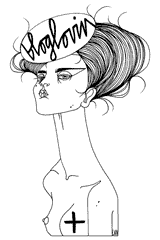
|
WomenKind - Why we need more time, and less clothes. @ Wednesday, September 14, 2016 Source Recently we came across WomenKind, an online and thought-provoking quarterly magazine with no ads, it's more of a publication like Dumbo Feather rather than your usually glossy magazine offering solutions for the way you look with, weight loss tips the and first third being purely ads. Instead of envy and want WomenKind offers articles than reflect our habits, lives and society, reflecting upon what it is that really important. This to me is what's really worth reading. 
Mad Men - Marketing cigarettes just as it's discovered they'll kill you.
Why do we work so much? Why don’t we curate our lives so we can spend joyful hours painting, thinking, reading, going for long walks with our lover – why don’t we pursue the carefree life indefinitely, one of enjoying periods of rest, of learning, of growing? Why do we take more pay over less work? What’s wrong with us? Juliet Schor, professor of sociology at Boston College has spent the past decade or so trying to understand why people work so much, often in jobs they don’t like. “Why don’t people save money so they can work less in the future?” she asks. “Why do people just take the money and spend it?” Schor argues that a lot of our spending behaviour comes from trying to keep up with a rising standard of living. We feel almost forced to buy things for fear of falling behind. We feel compelled to take out a loan to buy a house, a car, a constantly rotating wardrobe because everyone else is doing it, family, friends, work colleagues as well as the people we see on television, movies, advertising, newspapers and magazines. In fact it’s this latter category that often has the biggest pull on us. It’s the lifestyle of the wealthy that’s mainly shown in the media, talked about in newspapers and lifestyle sections, says Schor. “The media is increasingly orientated towards the lifestyles of the very top, and what I found in the US was that more people across the income spectrum were looking to that increasingly luxurious lifestyle for themselves.” The “good life” in the media is about owning lots of stuff, jet-setting around the globe to go shopping and expanding everything from houses, to kitchens, businesses to economies. The good life is never depicted as a life of ample time – time to play the cello, write, plant flowers, or sit around doing nothing but chatting with friends. Indeed, the media has taught us to equate owning lots of products with a high standard of living, as opposed to growing other aspects of our life such as cultivating skills and friendships. “We have a lot of stuff but we are poor in terms of our time and control of our time,” says Schor. “We must shift onto a path where we are less orientated to accumulating stuff and more orientated to accumulating time, connecting with people, building social capital. It is not how many toys you have when you die; it is much more the richness of your social life, that’s what really matters.” The obsession with buying stuff to gain a high standard of living is most apparent in the fashion industry; in our McFashion world clothes are churned out in factory lines much like sausages, bundled up in plastic wrapping and shipped across the seas. Hardly any fashion these days is manufactured in small local shops with local seamstresses. The glut of fashion is evident in the waste stream, ever-rising volumes of fashion stuffed down chutes in apartment blocks, buried in wheelie bins, and draped across rubbish tips; the previous season’s jackets, skirts, tops and pants are clogging up the arteries of our cities. Schor notes that textile rubbish in the US is a growing component of people’s garbage; figures from 2007 reveal that 35 kilograms per person of fashion is tossed into the garbage each year. The most revealing fact about the contemporary fashion industry, notes Schor, is that clothing can now be purchased by weight rather than by the piece, and at a price as low as two dollars a kilo. Now, it’s even possible to buy high-end apparel for less than rice, beans and other basic foodstuffs – a boon for fashion houses, but a disaster for the planet. Social scientists say that when we view an image of a fashion model wearing a dress, a photograph displayed online or in a magazine, we consume the image and symbol of the dress; perhaps the dress represents for us a feeling of scaling up to higher living standards just like the people on television. The physical dress – its fabric, lining, and buttons – is for the most part irrelevant, and so is the 20-something Chinese girl who sews its seams in a factory. Interestingly, on the other side of the world, the factory girl has dreams just like our own of working hard so that one day she can enjoy the life beamed down to her via television sets and cinemas: the big house, the car, lavish parties, expensive education for her future children. She works for the same symbol that we do. “It’s not only the planet that suffers in this stage of consumer culture,” writes Schor in her book True Wealth. “The fast-fashion dynamic puts enormous pressure on consumers to keep up with what can at times feel like a dizzying acceleration in norms. It’s financially exhausting, and requires time to shop, compare prices, and learn to operate new technologies. Fast fashion fosters an unhealthy dissatisfaction with what one has and anxiety about falling behind.” It’s not just fashion that’s turning our planet into a rubbish tip. We’ve somehow turned everything into a symbol of plentitude, from cars and bed linen to fancy vacuum cleaners. British sociologist Mike Featherstone calls it the “aestheticisation of everyday life,” pointing out that every aspect of life is an opportunity for aesthetic expression (the appreciation of beauty and art), from pens to bags, kettles to watches. We somehow use these items to shape our identities; for instance, we buy the rustic kettle to signify an “organic, herbal, naturalist” self, but then we might replace it with a decorative Japanese kettle to signify a “Taoist, meditative” self. In the past, in contrast, items were used for their function. A kettle was used to boil water and it is unlikely to have even crossed people’s minds whether the neighbour had an identical kettle or not. If someone were to have said to a person a hundred years ago that they should ditch their kettle because it had fallen out of fashion, they would have thought that person was stark raving mad. The trouble with placing a symbolic value on almost every tool we use – from vacuum cleaners to mobile phones – is that marketing gurus are constantly changing the signs on us, of what’s in and what’s out. “If what is symbolically valued remains so for only a brief period of time, then replacement goods become necessary,” writes Schor. Indeed, we’re forced to ditch, research the new products on offer, shop, buy, ditch again, and the cycle is endless, expensive, exhausting, and we have to work more and more hours to get back to where we started.  “If you look at what the growth model is doing to people in terms of their mental health, their physical health, their subjective well-being and all of those things – it is not as though the current system is giving us nirvana and oh dear we see that here is an ecological problem. It is undermining the well-being of the planet and its people,” says Schor. So what’s the answer? “We need a new set of values and culture,” concludes Schor. “We need to talk postgrowth.” |

Hi. I'm Charlie. Capricorn. ISFJ. An Events Planner. An American, San Franciscan in Melbourne. This is a blog about food, events, desserts, hot chocolate & cupcakes, shopping, and the occasional beauty product review in between. A lifestyle blog by an American in Melbourne. Want to contact me? For invites, restaurant reviews and product reviews contact us at the address below. Click here to email me. I'm always after new places to try!  Follow Me? 

  Sticky Posts  The Cast The Cast My Wishlist My Wishlist All About Eggs All About Eggs Bursaria's Lemonade Bursaria's Lemonade Projects Half Done
Projects Half Done Adventures of Spending while Saving Adventures of Spending while SavingPublic Relations Archives July 2014 August 2014 September 2014 October 2014 November 2014 December 2014 January 2015 February 2015 March 2015 April 2015 May 2015 June 2015 July 2015 August 2015 September 2015 October 2015 November 2015 December 2015 January 2016 February 2016 March 2016 April 2016 May 2016 June 2016 July 2016 August 2016 September 2016 October 2016 November 2016 December 2016 January 2017 February 2017 March 2017 April 2017 May 2017 June 2017 July 2017 August 2017 September 2017 October 2017 November 2017 December 2017 January 2018 February 2018 April 2018 May 2018 June 2018 July 2018 August 2018 September 2018 November 2018 December 2018 January 2019 February 2019 March 2019 April 2019 May 2019 June 2019 July 2019 August 2019 September 2019 November 2019 December 2019 January 2020 February 2020 March 2020 April 2020 November 2020 December 2020 January 2021 May 2021 Thanks to... Original Base Design
Base Editor - Erma97 Basecoder - detonatedlove Original Header Design teacakehouse Coding Assistance (IT) Kitty_meow & Bala Kumaran Disclaimer Any resemblance to real or fictitious names, identities, characters, persons, whether living or dead, settings, situations, or other information, is purely coincidental and unintentional. Bloglovin' |
